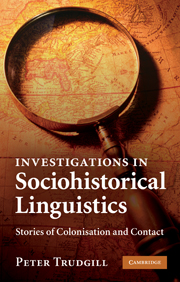Book contents
- Frontmatter
- Contents
- List of maps
- List of tables
- Acknowledgements
- Prologue: Colonisation and contact
- 1 What really happened to Old English?
- 2 East Anglian English and the Spanish Inquisition
- 3 On Anguilla and The Pickwick Papers
- 4 The last Yankee in the Pacific
- 5 An American lack of dynamism
- 6 Colonial lag?
- 7 “The new non-rhotic style”
- 8 What became of all the Scots?
- Epilogue: The critical threshold and interactional synchrony
- Bibliography
- Index
Epilogue: The critical threshold and interactional synchrony
Published online by Cambridge University Press: 02 December 2010
- Frontmatter
- Contents
- List of maps
- List of tables
- Acknowledgements
- Prologue: Colonisation and contact
- 1 What really happened to Old English?
- 2 East Anglian English and the Spanish Inquisition
- 3 On Anguilla and The Pickwick Papers
- 4 The last Yankee in the Pacific
- 5 An American lack of dynamism
- 6 Colonial lag?
- 7 “The new non-rhotic style”
- 8 What became of all the Scots?
- Epilogue: The critical threshold and interactional synchrony
- Bibliography
- Index
Summary
In the eight chapters which have preceded this Epilogue, I have tried to find solutions to puzzles about why certain language varieties are like they are. In every case, to a greater or lesser extent, those solutions have been couched at least partly in terms of contact between language varieties.
In some cases it was mostly language contact that the investigation focussed on. Contact between the West Germanic Old English and the Brythonic Celtic Late British, as discussed in Chapter 1, was clearly language contact. I argued that it was contact between the Old English of the newcomers and the Late British of the indigenous inhabitants that led, originally in the English spoken by adult Brythonic speakers, to the simplification that took place in English during the first centuries of its existence in Britain. The discussion of the surprising but highly probable effects of the Spanish Inquisition on the nature of East Anglian dialects of English in Chapter 2 also saw the importance of contact that was clearly of the language-contact type. It appears to be rather important, too, that the contact involved three languages rather than two: (Walloon) French, (Flemish) Dutch and (Norwich) English. And in Chapter 5, in the discussion of differences in dynamism as between American and British Isles English to have, I also discussed contact between English in the United States and other languages such as Dutch, French, Spanish, Yiddish and German.
- Type
- Chapter
- Information
- Investigations in Sociohistorical LinguisticsStories of Colonisation and Contact, pp. 181 - 192Publisher: Cambridge University PressPrint publication year: 2010

